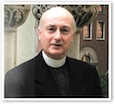The curious saga of the salamander
- FATHER GEORGE RUTLER
In the winter months, it would be salutary for people young and old to put down their iPods and other electronic devices and tell each other stories.
 Any subject will do, and I submit as an example the curious saga of the salamander. That strange sort of lizard hibernates in the hollows of logs and jumps out when the wood is burning. That probably was the source of legends about them and flames. Over three centuries before the Incarnation, Aristotle was writing about this. A few decades after the Resurrection, Pliny the Elder, a naturalist whose curiosity about curiosities led to his death when Vesuvius destroyed Pompeii, was skeptical about such tales. But the Talmud claims that salamanders were born from fire, and according to one ninth-century commentator, Mohammed listed salamanders among things he did not like and that should be crushed.
Any subject will do, and I submit as an example the curious saga of the salamander. That strange sort of lizard hibernates in the hollows of logs and jumps out when the wood is burning. That probably was the source of legends about them and flames. Over three centuries before the Incarnation, Aristotle was writing about this. A few decades after the Resurrection, Pliny the Elder, a naturalist whose curiosity about curiosities led to his death when Vesuvius destroyed Pompeii, was skeptical about such tales. But the Talmud claims that salamanders were born from fire, and according to one ninth-century commentator, Mohammed listed salamanders among things he did not like and that should be crushed.
In the twelfth century, Pope Alexander III prized a cloak made of salamander skins. This great friend of Saint Thomas Becket (whom he canonized) was not superstitious, and in fact helped charter Oxford and other universities, but he may have thought it would impress the haughty emperor, Frederick Barbarossa. In the sixteenth century, Mary Queen of Scots adopted the salamander as a symbol, it having been an emblem of her grandfather-in-law, King Francis I of France. You can see it at the beautiful Château d'Azay-le-Rideau. It just happened that the mother of her second husband was of the Clan Douglas whose emblem is a green salamander. As one legend has the salamanders bursting into fire as they died, it was fitting that Lord Darnley was strangled and blown up. But the legend had the salamander rising to life again from its ashes, and this is why Queen Mary needlepointed an image of the salamander while waiting in prison for her execution, and took as a motto, "In my end is my beginning."
If all this seems a bit arcane, in more recent popular culture P.G. Wodehouse's character Gussie Fink-Nottle had a hobby of breeding newts, which are a form of salamander. Auberon Waugh, son of the great Catholic novelist Evelyn Waugh, compared the socialist mayor of London, Ken Livingstone, who was a serious expert on newts, to Gussie.
Now, among the stories ever told, the greatest, and truest, is the Advent of Christ into the world. C.S. Lewis, having written about this metaphorically in his Narnia tales, said: "Christianity is the story of how the rightful king has landed, you might say in disguise, and is calling us all to take part in His great campaign of sabotage."
That king is Jesus Christ, and his great campaign was against the Prince of Lies. The sabotage worked: "For since death came through a man, the resurrection of the dead comes also through a man" (1 Corinthians 15:21). In our end is our beginning.
 This is Meaghen Gonzalez, Editor of CERC. I hope you appreciated this piece. We curate these articles especially for believers like you.
This is Meaghen Gonzalez, Editor of CERC. I hope you appreciated this piece. We curate these articles especially for believers like you.
Please show your appreciation by making a $3 donation. CERC is entirely reader supported.

Acknowledgement
 Father George W. Rutler. "The curious saga of the salamander." From the Pastor (November 27, 2016).
Father George W. Rutler. "The curious saga of the salamander." From the Pastor (November 27, 2016).
Reprinted with permission from Father George W. Rutler.
The Author
 Father George W. Rutler is the pastor of St. Michael's church in New York City. He has written many books, including: The Wit and Wisdom of Father George Rutler, The Stories of Hymns, Hints of Heaven: The Parables of Christ and What They Mean for You, Principalities and Powers: Spiritual Combat 1942-1943, Cloud of Witnesses — Dead People I Knew When They Were Alive, Coincidentally: Unserious Reflections on Trivial Connections, A Crisis of Saints: Essays on People and Principles, Brightest and Best, and Adam Danced: The Cross and the Seven Deadly Sins.
Father George W. Rutler is the pastor of St. Michael's church in New York City. He has written many books, including: The Wit and Wisdom of Father George Rutler, The Stories of Hymns, Hints of Heaven: The Parables of Christ and What They Mean for You, Principalities and Powers: Spiritual Combat 1942-1943, Cloud of Witnesses — Dead People I Knew When They Were Alive, Coincidentally: Unserious Reflections on Trivial Connections, A Crisis of Saints: Essays on People and Principles, Brightest and Best, and Adam Danced: The Cross and the Seven Deadly Sins.




